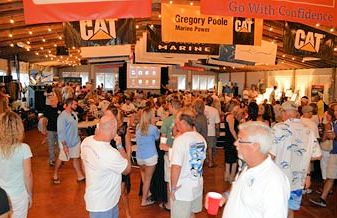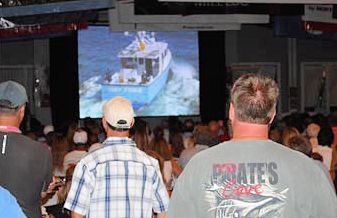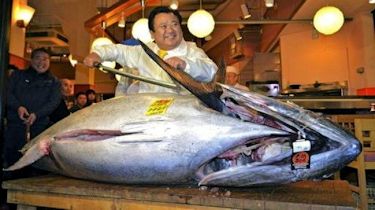Reprinted from the Island Free Press
MANTEO — In what was likely the first time a bitter feud over fisheries quota has been transformed into swaggering entertainment, a recent sneak preview of the premier of “Wicked Tuna: North vs. South” was met with raucous whooping and cheers by Outer Bankers at a standing-room only gala at Pirate’s Cove Marina in Manteo.
The spinoff of the popular “Wicked Tuna” reality series began Sunday on the National Geographic Channel. It was shot last winter off Hatteras and Oregon inlets, featuring local boats and Outer Banks fishermen battling “invading” Yankee watermen – who had a rough season up North — for the notoriously limited bluefin tuna quota off Outer Banks waters.
The valuable fish is strictly regulated, but North Carolina fishermen, who fish for bluefin in the winter, have complained for years that the annual allotted bluefin quota favors the northern fishermen who fish for bluefin earlier in the year.
Supporter Spotlight
“They made it a geographical quota,” Greg Mayer, one of the show’s southern captains, said before the presentation. “Basically, in North Carolina, we are screwed. It’s wrong.”
A large bluefin, prized for sushi, can be worth as much as $20,000 to the fisherman.
 The sneak preview drew a crowd in Manteo. Photo: Rob Alderman, Island Free Press |
 People hooted and hollered for their favorite fishing boat. Photo: Rob Alderman, Island Free Press |
Hundreds of local residents and public officials mingled over drinks and food at the marina before the big screen lit up with familiar scenes of fishing boats and sunrise over sparkling water. Many folks in the crowd were also in town for the Pirate’s Cove Big Game Tournament.
Then a male voiceover, with an exaggerated gravitas, immediately stoked the rival fires, to the delight of the audience. “It’s a clash of cultures . . . an all-out competition,” the voice boomed. “With their livelihoods at stake, this war will be anything but civil.”
Soon, close-ups of local fishermen filled the screen: Reed Meredith, captain of the Wahoo and his brother Banks, the first mate; Britton Shackelford, captain of the Doghouse – shown both bearded and smooth-shaven – and his mate, Caine Livesay; and Greg Mayer, captain of the Fishin’ Frenzy, and his mate, Nick Gowitzka.
Supporter Spotlight
Scary music accompanied the first appearance of a northern vessel, the Hot Tuna, captained by wild-haired and bearded T.J. Ott, who could slap a patch over his eye and look just like a pirate.
Then over the horizon came the Hard Merchandise, captained by tough-talker Dave Marciano.
“The bottom line is,” he tells the camera, “I’ve got 15 grand tied up in this operation and (we’re) going to get our share, whether they like it or not.”
“It’s a Yankee invasion!” exclaimed Banks Meredith in response.
The contrast of the sharp-edged Boston accents with the southern drawls of the two sides helped distinguish the competitors, who all shouted and cursed and harpooned and reeled and laughed with impressive vigor.
Before and after the nearly hour-long presentation, a steady stream of people came up to the men, now apparent celebrities. At times appearing slightly stunned, they graciously signed numerous autographs and patiently posed for photographs.
Only one Gloucester, Mass., fisherman, Paul Hebert, was able to attend the screening.
Like many of his Outer Banks cohorts, Hebert, the youngest of six boys, is a member of a multi-generational fishing family. “I’ve been doing it my whole life,” he said. “I caught my first bluefin tuna when I was 8 years old.”
Not only was his 76-year-old father a legendary fisher, he said his mother also fished.
Pulling out his cell phone, he showed an old photograph of his mother standing beside a 782-pound tuna she had caught.
Hebert, who is co-captaining the Pin Wheel with Capt. Tyler McLaughlin, doesn’t make an appearance until the end of the first show, when he is shown with a big smile, cackling, “The Yanks are coming!”
Although he would not go into detail when asked how his boat did, Hebert volunteered that they did “very, very good.”
Yes, and so did the Outer Bankers, Banks Meredith hinted. “Well, we represented the South very well,” he said. “Fishermen out of here are world class.”
Whatever competition the fishermen have is in large part the nature of fishing, they agreed.
“We’re after the same fish,” Hebert said.
“Every boat that’s out there is fishing against me –against us,” Mayer said.
But Shackelford said that the resentment toward the Yankees – which is how the North Carolina tuna fishermen at countless fisheries meetings have referred to their northern counterparts – is based on the way the fisheries regulators have divvied up the quota for the last 20 years or so.
As a migratory species with a vast range, bluefin tuna is managed by different international, national, regional and state panels. Consequently, the quota for the very valuable fish has become mired in politics and controversy.
But southern watermen have urged fisheries managers to allow them to fish bluefin for longer periods in the winter so they have more opportunity to claim their fair share of quota. The way it is now, they contend, the northern watermen have more time to catch more fish and get an unfair share of the quota before the tuna head south.
“That’s where management makes a rivalry between us,” Shackelford said. “If they catch a fish today, it’s a fish I may not get. It’s a very intense rivalry.”
“Wicked Tuna: North vs. South” continues on Sunday and again on Aug 31. The new series will air internationally on National Geographic Channel in 170 countries and 45 languages beginning this fall.
Bluefin TUNA IN WICKED TROUBLEStaff Report
Bluefin tuna is the most valuable fish in the world. Coveted for its fatty belly meat, it is highly prized in Japanese sushi as toro or maguro. A single bluefin tuna last year brought more than $1.8 million in Tokyo, where the world’s premium bluefin are sold at auctions. It doesn’t take a Ph.D. in marine biology, then, to figure out why bluefin now seem destined for extinction. The population of western Atlantic bluefin tuna, like those featured in National Geographic’s new reality show, has been reduced by more than 82 percent. The International Commission for the Conservation of Atlantic Tunas is the organization in Madrid that regulates – a word that should be used loosely, critics charge – tuna fishing worldwide. It estimates that fewer than 25,000 individual mature Atlantic bluefin remain. Many Western nations, including the United States, have called for an international ban on bluefin fishing. Decades of overfishing, loss of their prey and tuna ranching all threaten the species. Taxonomy and range: Three species of bluefin tuna are found around the world – Northern, or Atlantic, (Thunnus thynnus); Southern (Thunnus maccoyii); and Pacific (Thunnus orientalis). Northern bluefin are native to both the western and eastern Atlantic Ocean and the Mediterranean Sea but have become extinct in the Black Sea. In the western Atlantic, bluefin are found from Newfoundland to the Gulf of Mexico. In the eastern Atlantic, they range from south of Iceland to the Canary Islands and throughout the Mediterranean. Description: Bluefin are built for speed. They have large, torpedo-shaped bodies that are nearly circular in cross-section. They cruise along at about 10 miles an hour but can reach speeds of up 50 mph when chasing a meal. The largest of the tuna species, bluefin can reach up to 13 feet and 2,000 pounds. They are dark blue-black on the back and white on the lower sides and belly. Live bluefin have colorless lines alternating with rows of colorless spots on their lower sides. Biology: Bluefin grow more slowly than other tunas and have a long lifespan, up to 20 years or more. In the western Atlantic, they
mature late in life, around age 8 or older. They spawn from mid-April to June, mainly in the Gulf of Mexico. Females can produce up to 10 million eggs a year. The eggs are fertilized in the water column and hatch in about two days, but the larvae have only a one in 40 million chance of reaching adulthood. Prey: Tuna are fearsome predators from the moment they hatch. They hunt by sight and have the sharpest vision of any bony fish. Adult Atlantic bluefin eat schooling fish like herring, mackerel, flying fish and anchovies, as well as squid, eels, crustaceans and occasionally starfish and even kelp. They can dive to around 3,000 feet to find food. Conservation Status: All species of bluefin are considered to be severely overfished and likely to go extinct without tighter controls on legal and pirate fishing. Ironically, bluefin had little commercial value before 1970. Those trophy tuna that weren’t hung on the wall were usually sold for cat and dog food. But then the Japanese developed a yen for toro in the early 1970s, and the giants suddenly were worth big money to traditional sport fishermen. Fishing for bluefin predictably exploded, soon reaching unsustainable levels. Now, most recreational fisherman also have commercial permits, so that virtually all giant bluefin currently caught are marketed. More than three-quarters of the fish caught are consumed in Japan. Smaller fish are also gathered live and put in pens to “fatten up” before slaughter. |










